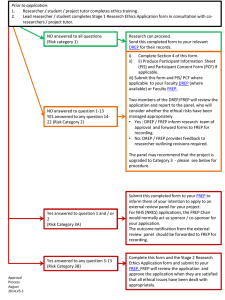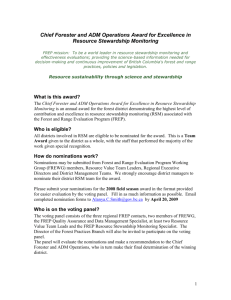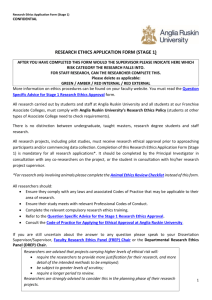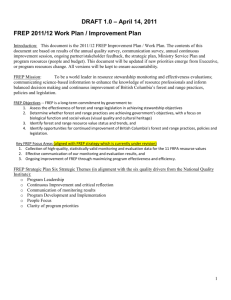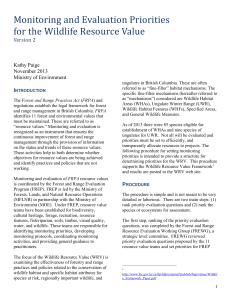OIF Nanaimo
advertisement
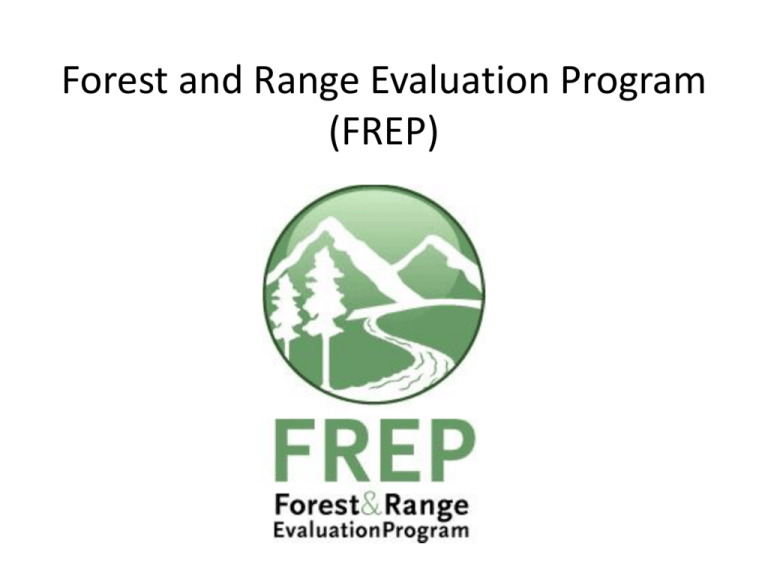
Forest and Range Evaluation Program (FREP) Forest & Range Evaluation Program •Overview of FREP •Evaluation process •Linkages to policy, practices and legislation •Communication of FREP findings •Riparian results Results-based, Professional Reliance Model FRPA Objectives Plan & Practice Requirements Professional Reliance Effectiveness Evaluation Compliance and Enforcement FREP Objectives • Assess the effectiveness of legislation • Determine if outcomes are consistent with government’s objectives • Identify resource value status and trends, and • Communicate opportunities for continued improvement. FREP Mission ...communicating science-based information to enhance the knowledge of resource professionals and inform balanced decision making and continuous improvement... Resource Values Being Monitored Minimum targets Priority based Development Stand-level Biodiversity Cultural Heritage Landscape-level Biodiversity Riparian (fish) Soils Resource Features Water Quality Timber Multi-Resource Visual Quality Forage Wildlife Published Not Published In progress FREP Sampling Locations How the Program Works 8 Evaluation Question Are riparian forestry and range practices effective in maintaining the structural integrity and functions of stream ecosystems and other aquatic resource features over both short and long terms? Indicator and Protocol Development Riparian Protocol Development Team: •Peter Tschaplinski, B.C. Ministry Forests, Mines and Lands; •Dan Hogan, B.C. Ministry Forests, Mines and Lands; •Derek Tripp, Consulting Biologist; •Steve Bird, Consulting Geomorphologist; •Richard Thompson and Andrew Witt, B.C. Ministry of Environment; •Steve Chatwin and Kevin Edquist, Forest Practices Board of British Columbia; •Erland MacIsaac, Department of Fisheries and Oceans Canada; •John Richardson, the University of British Columbia •Wendy Bergerud, Research Branch, B.C. Ministry of Forests, Mines and Range, (sampling) Data Collection • Field staff • Training • Data quality checks • Data verification Results Analysis: •Amanda Linnell Nemec, International Statistics Research •Peter Tschaplinski and • Derek Tripp Expert Review: •Dr. Robert Bilby, Weyerhaeuser Company •Dr. Sherri Johnson, U.S. Department of Agriculture, Forest Service •Steve Smith, Leader, National Riparian Service Team, U.S. Department of Interior, BLM •Janice Staats, Hydrologist, National Riparian Service Team, U.S. Department of Interior, BLM •Dr. John Rex, B.C. Ministry of Forests, Mines and Lands •Dr. Katherine Sullivan, Humboldt Redwood Company •Dr. Gordon Hartman, Consulting Fisheries Biologist and Fisheries and Oceans Canada (retired), and •Dr. Todd Redding, FORREX. Continued improvement: Communication to maximize use of data and findings Professional Reliance Cumulative Effects Results Based Forestry Uses of FREP Climate Change Certification Policy & Legislation Knowledge of Land Base Compliance & Enforcement Professional Reliance: … the specialized knowledge that professionals bring to their practice… …professionals, on a regular and consistent basis, maintain a currency of knowledge and incorporate this knowledge into their practice. ...government and industry rely on the judgement of resource professionals who are held accountable for their actions by the Association... Mike Larock, ABCFP FREP Tools for Professional Reliance • Training • Protocols and indicators • Data • Results -- extension products • Recommendations (e.g., CF Report) • Resource Value Team Leads • District field staff Communicating FREP Results – Biodiversity – Cultural Heritage – Fish/Riparian – Forage – Soils – Timber – Visual Quality – Water Quality – Wildlife – Recreation Communicating FREP Results http://www.youtube.com/user/frep101 Communicating FREP Results Thanks FREP Communication in 2011 Supporting professional reliance and the resultsbased framework through: Getting information into the right hands in a timely manner Continued focus on short extension notes Clear and direct feedback to clients, including their data Focus on facts Non-directive Face to face Partnerships FREP Strategic Plan 3 Key Focus Areas: 1. High Quality Data 2. Communication 3. Continuous Improvement FREP over the next 2-3 Years Implement the Strategy: – 3 key focus areas • • • – – – Quality Communication Continuous Improvement Multiple resource value assessment Landscape-level (biodiversity and other values) Cumulative effects
